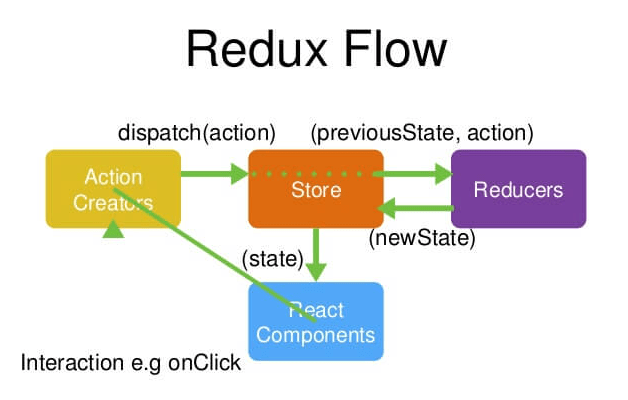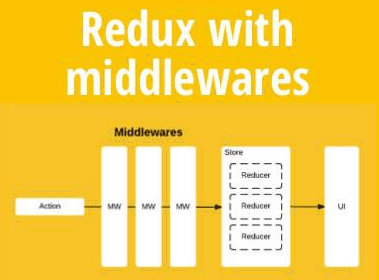参考
Redux 入门教程(一):基本用法
Redux 入门教程(二):中间件与异步操作
Redux 入门教程(三):React-Redux 的用法
Redux简介
先简单说一下Flux。Flux是一种架构思想,专门解决软件的结构问题,它最大特点是数据的”单向流动”。React本身只涉及UI层,如果搭建大型应用,必须搭配一个前端框架,Facebook官方使用的是 Flux框架。Redux将Flux与函数式编程结合一起,很短时间内就成为了最热门的前端架构。
“如果你不知道是否需要 Redux,那就是不需要它。”
“只有遇到 React 实在解决不了的问题,你才需要 Redux 。”
适用场景
- 用户的使用方式复杂
- 不同身份的用户有不同的使用方式(比如普通用户和管理员)
- 多个用户之间可以协作
- 与服务器大量交互,或者使用了WebSocket
- View要从多个来源获取数据
从组件角度看,如果有以下场景,可以考虑使用 Redux
- 某个组件的状态,需要共享
- 某个状态需要在任何地方都可以拿到
- 一个组件需要改变全局状态
- 一个组件需要改变另一个组件的状态
设计思想
(1)Web 应用是一个状态机,视图与状态是一一对应的。
(2)所有的状态,保存在一个对象里面。
工作流程

- 用户发出 Action,
store.dispatch(action); - Store 自动调用 Reducer,
let nextState = todoApp(previousState, action); - State 一旦有变化,Store 就会调用监听函数,监听函数可以通过store.getState()得到当前状态,可以触发重新渲染View
|
|
基本概念
Store
Store 就是保存数据的地方,可以把它看成一个容器,整个应用只能有一个Store,Redux提供createStore函数用来生成Store。
State
Store对象包含所有数据。如果想得到某个时点的数据,就要对Store生成快照。这种时点的数据集合,就叫做State。当前时刻的State,可以通过store.getState()拿到。Redux 规定, 一个 State 对应一个 View,只要 State 相同,View 就相同,反之亦然。
Action
State的变化必须是View导致的,Action就是View发出的通知,描述当前发生的事情,表示State应该要发生变化了。Action是一个对象,其中的type属性是必须的,表示Action的名称,其他属性可以自由设置。
Action Creator
每个Action都手写会很麻烦,用来生成Action的函数就叫Action Creator。
store.dispatch()
store.dispatch()是View发出Action的唯一方法,通常会结合Action Creator使用。
Reducer
Store收到Action以后,必须给出一个新的State,这样View才会发生变化。这种State的计算过程就叫做Reducer,Reducer是一个函数,它接受Action和当前State作为参数,返回一个新的State。Reducer函数最重要的特征是,它是一个纯函数,只要是同样的输入,必定得到同样的输出。因此,Reducer 函数里面不能改变State,必须返回一个全新的对象。
实际应用中,Reducer函数不用像上面这样手动调用,store.dispatch方法会触发Reducer 的自动执行。为此,Store需要知道Reducer函数,做法就是在生成Store的时候,将Reducer传入createStore方法,以后每当store.dispatch发送过来一个新的Action,就会自动调用Reducer,得到新的State。createStore方法还可以接受第二个参数,表示State的最初状态,这通常是服务器给出的,如果提供了这个参数,它会覆盖Reducer函数的默认初始值。
为什么这个函数叫做Reducer呢?因为它可以作为数组的reduce方法的参数,Array.prototype.reduce(reducer, ?initialValue),一系列Action对象按照顺序作为一个数组,对每个Action调用reducer。请看下面的例子。
Reducer拆分
Redux提供了一个combineReducers方法,用于Reducer的拆分,只要定义各个子Reducer函数,然后将它们合成一个大的Reducer。这种拆分与React应用的结构相吻合:一个React根组件由很多子组件构成,子组件与子Reducer完全可以对应。
store.subscribe()
Store 允许使用store.subscribe方法设置监听函数,一旦State发生变化,就自动执行这个函数。因此,只要把View的更新函数(对于React项目,就是组件的render方法或setState方法)放入listen,就会实现View的自动渲染。store.subscribe方法返回一个函数,调用这个函数就可以解除监听。
中间件

中间件就是一个函数,对store.dispatch方法进行了改造,在发出Action和执行Reducer这两步之间,添加了其他功能。
使用中间件
异步操作的思路
- 操作开始时,送出一个Action,触发State更新为”正在操作”状态,View重新渲染
- 操作结束后,再送出一个Action,触发State更新为”操作结束”状态,View 再一次重新渲染
方式一:redux-thunk
异步操作至少要送出两个Action,如何才能在操作结束时,系统自动送出第二个 Action 呢?奥妙就在 Action Creator 之中。
这样的处理,就解决了自动发送第二个Action的问题。但是,又带来了一个新的问题,Action是由store.dispatch方法发送的,而store.dispatch方法正常情况下,参数只能是对象,不能是函数。这时,就要使用中间件redux-thunk,改造store.dispatch,使得后者可以接受函数作为参数。
redux-thunk 的实现非常简单:
方式二:redux-promise
另一种异步操作的解决方案,就是让Action Creator返回一个Promise对象。这就需要使用redux-promise中间件,这个中间件使得store.dispatch方法可以接受Promise对象作为参数。
React-Redux的用法
React-Redux将所有组件分成两大类:UI组件(presentational component)和容器组件(container component)。
UI 组件有以下几个特征:
只负责 UI 的呈现,不带有任何业务逻辑
没有状态(即不使用this.state这个变量)
所有数据都由参数(this.props)提供
不使用任何 Redux 的 API
容器组件有以下几个特征:
负责管理数据和业务逻辑,不负责 UI 的呈现
带有内部状态
使用 Redux 的 API
UI组件负责UI的呈现,容器组件负责管理数据和逻辑。如果一个组件既有UI又有业务逻辑,将它拆分成外面是一个容器组件,里面包了一个UI组件,前者负责与外部的通信,将数据传给后者,由后者渲染出视图。React-Redux规定,所有的UI组件都由用户提供,容器组件则是由 React-Redux 自动生成。
connect
connect方法,用于从UI组件生成容器组件,connect的意思,就是将这两种组件连起来。
TodoList是UI组件,VisibleTodoList就是由React-Redux通过connect方法自动生成的容器组件。但是,因为没有定义业务逻辑,上面这个容器组件毫无意义,只是UI组件的一个单纯的包装层。为了定义业务逻辑,需要给出下面两方面的信息:
(1)输入逻辑:外部的数据(即state对象)如何转换为 UI 组件的参数。
(2)输出逻辑:用户发出的动作如何变为 Action 对象,从 UI 组件传出去。
mapStateToProps
mapStateToProps是一个函数,它建立一个从外部的state对象到UI组件的props对象的映射关系。mapStateToProps会订阅 Store,每当state更新的时候,就会自动执行,重新计算 UI 组件的参数,从而触发 UI 组件的重新渲染。
mapStateToProps的第一个参数总是state对象,还可以使用第二个参数,代表容器组件的props对象。使用ownProps作为参数后,如果容器组件的参数发生变化,也会引发UI组件重新渲染。
mapDispatchToProps
mapDispatchToProps用来建立UI组件的参数到store.dispatch方法的映射,它定义了哪些用户的操作应该当作Action传给Store。它可以是一个函数,也可以是一个对象。
如果mapDispatchToProps是一个函数,会得到dispatch和ownProps(容器组件的props对象)两个参数。
Provider
Provider组件,可以让容器组件拿到state。Provider在根组件App外面包了一层,这样一来,App的所有子组件就默认都可以拿到state了。它的原理是React组件的context属性,store放在了上下文对象context上面,子组件就可以从context拿到store了。
API的简单实现
createStore的简单实现
|
|
combineReducer的简单实现
|
|
applyMiddleware的简单实现
|
|
redux-promise的简单实现
|
|
Provider的简单实现
|
|